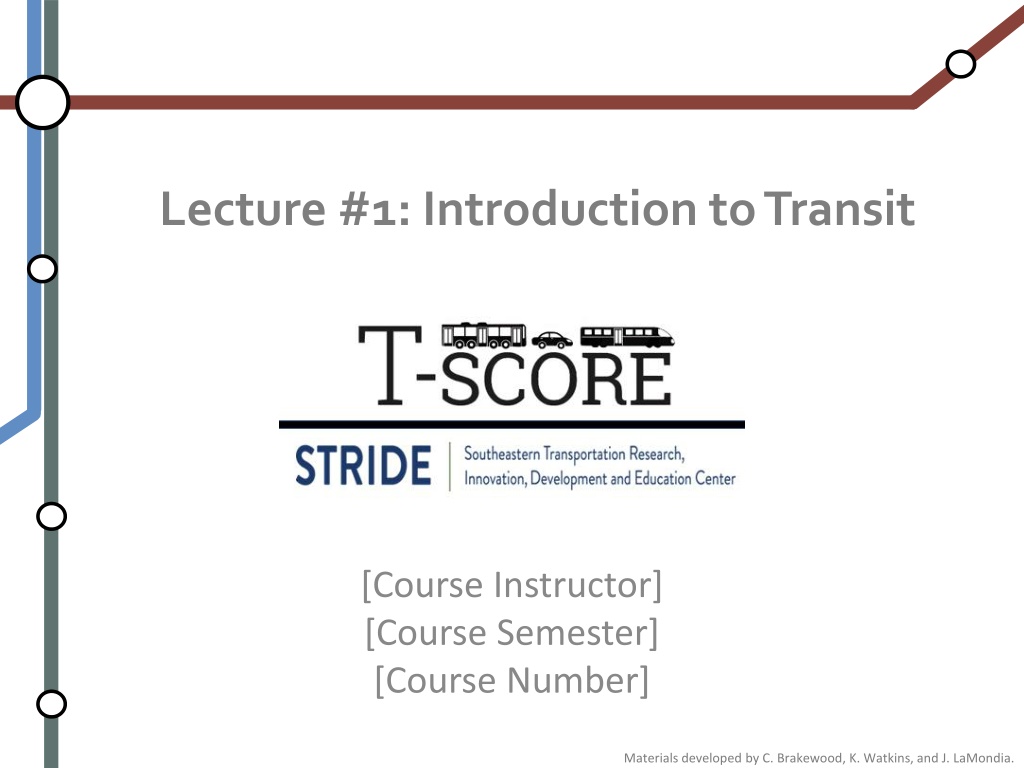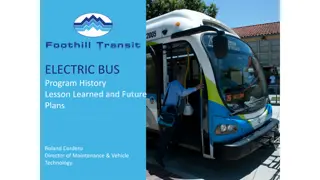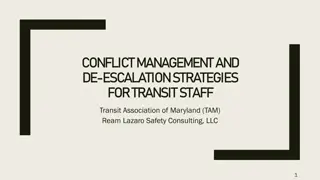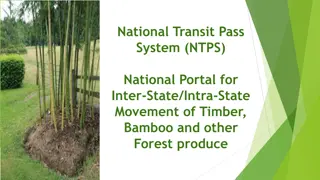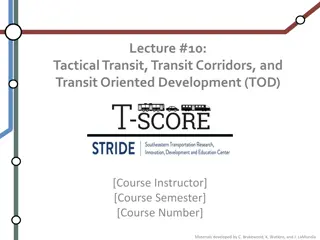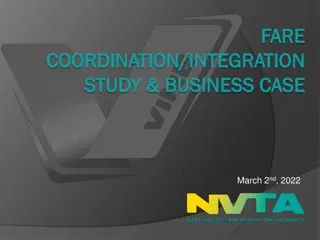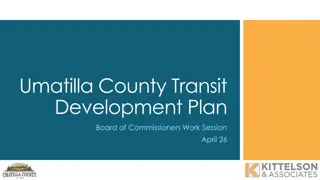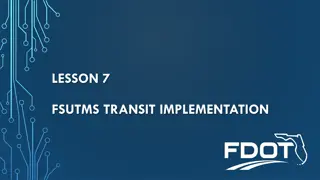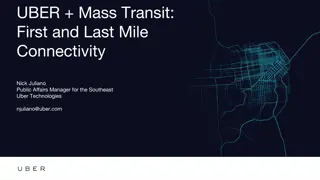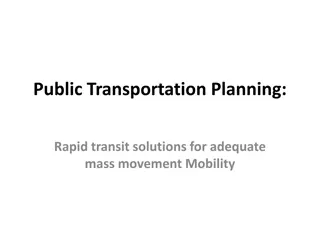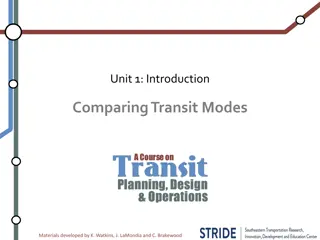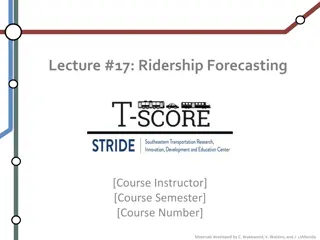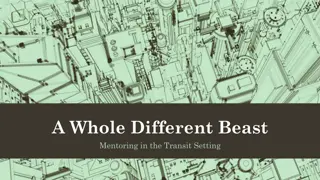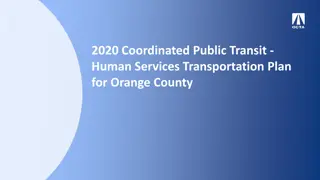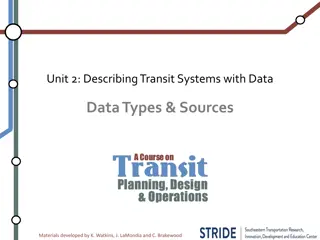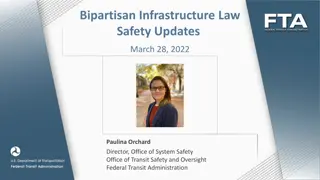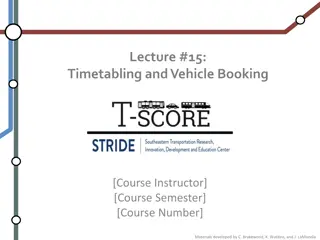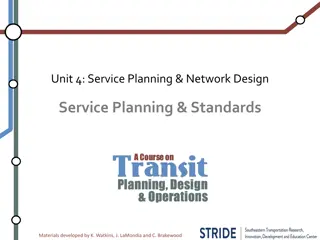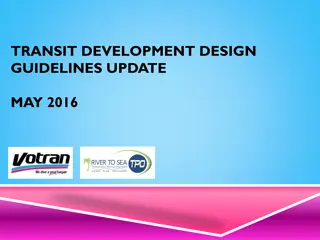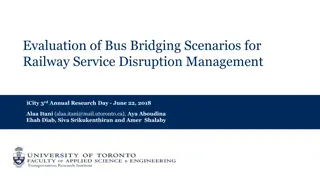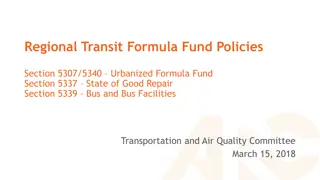Understanding Transit Systems: A Comprehensive Overview
Delve into the world of transit with this introductory lecture covering the definition, evolution, and importance of transit systems in the USA. Explore the various forms of transit, from public to private, and their role in collective transportation. Gain insights into the classification of transit modes and understand the distinctions between private and public transportation services.
- Transit systems
- Collective transportation
- Public vs private transit
- Evolution of transit
- Transportation classification
Download Presentation

Please find below an Image/Link to download the presentation.
The content on the website is provided AS IS for your information and personal use only. It may not be sold, licensed, or shared on other websites without obtaining consent from the author. Download presentation by click this link. If you encounter any issues during the download, it is possible that the publisher has removed the file from their server.
E N D
Presentation Transcript
Lecture #1: Introduction to Transit [Course Instructor] [Course Semester] [Course Number] Materials developed by C. Brakewood, K. Watkins, and J. LaMondia.
Outline What is transit? Why is transit important? Evolution of transit in the USA Transit today in the USA and [Your home state]
WHAT IS TRANSIT? Definitions of transit
Familiar Forms of Transit Image source: http://www.artandartdeadlines.com/2010/06/call-for- Image source: Chris Yunker, http://www.flickr.com/photos/chris- entries-transit-theme/ yunker/2478436403/
What is transit? The simple answer: collective transportation Jarrett Walker s answer: Public transit consists of regularly scheduled vehicle trips open to all paying passengers the capacity to carry multiple passengers trips that may have different origins, destinations, and purposes. Walker, Jarrett. Human Transit. Chapter 1, page 13
Are these transit, too? Image:Roosevelt Island Tramway.jpg
Classification: Private vs. Public Transportation Characteristic Private For-hire Public Designation Private Paratransit Transit Availability Owner Public Public Supplier User Carrier Carrier Route Determination User (Flexible) User User (Carrier) Carrier (Fixed) Time-Schedule Determination User (Flexible) User User (Carrier) Carrier (Fixed) Cost-Price User absorbs Fixed RATE Fixed FARE Carrier Type Individual Group Individual Group Group Modes ?? ?? ?? ?? ?? Adapted from Vuchic, 2007
Classification: Private vs. Public Transportation Characteristic Private For-hire Public Designation Private Paratransit Transit Availability Owner Public Public Supplier User Carrier Carrier Route Determination User (Flexible) User User (Carrier) Carrier (Fixed) Time-Schedule Determination User (Flexible) User User (Carrier) Carrier (Fixed) Cost-Price User absorbs Fixed RATE Fixed FARE Carrier Type Individual Group Individual Group Group Modes SOV Carpool ?? ?? ?? Motorcycle Vanpool ?? ?? ?? Bicycle ?? ?? ?? Walking ?? ?? ?? Adapted from Vuchic, 2007
Classification: Private vs. Public Transportation Characteristic Private For-hire Public Designation Private Paratransit Transit Availability Owner Public Public Supplier User Carrier Carrier Route Determination User (Flexible) User User (Carrier) Carrier (Fixed) Time-Schedule Determination User (Flexible) User User (Carrier) Carrier (Fixed) Cost-Price User absorbs Fixed RATE Fixed FARE Carrier Type Individual Group Individual Group Group Modes SOV Carpool Taxi/ Uber Dial-A-Ride Street Transit Rent Car/ Car Share Semi-Rapid Transit Motorcycle Vanpool Jitney Bicycle Bike Share Rapid Transit Scooter Share Walking Specialized Adapted from Vuchic, 2007
WHY IS TRANSIT IMPORTANT? The benefits of providing transit service
The Simple Answer: Space Image source: cyclingpromotion.com.au
Some Benefits of Transit Congestion Energy / Environment Equity Safety
Benefit #1: Congestion Source: 2012 TTI Urban Mobility Report Available: http://d2dtl5nnlpfr0r.cloudfront.net/tti.tamu.edu/documents/mobility-report-2012.pdf
Benefit #2: Environment/Energy The GHG emissions saved by passengers riding transit rather than using personal vehicles is about 9 MMT CO2e Transit vehicles are estimated to emit 12 million metric tons of carbon dioxide equivalents -Upstream 2.2 10.2 -Efficiency Upstream -Efficiency Direct -2.1 -7.0 -Direct & Indirect -51.2 Land use efficient: The GHG emissions saved by the broader impact of transit on vehicle miles traveled (VMT) in the community is about 66 MMT CO2e -Efficiency Direct -Efficiency Upstream -15.1 Net Impact: 12 MMT CO2e emitted 75 MMT CO2e reduced = 63 MMT CO2e TCRP Report 226 (2021): An Update on Public Transportation's Impacts on Greenhouse Gas Emissions Available at: http://www.trb.org/Main/Blurbs/181941.aspx
Benefit #3: Safety 32 x Source: 2016 APTA: The Hidden Traffic Safety Solution: Public Transportation
Benefit #4: Equity Source: APTA, 2007, Public Transportation and Petroleum Savings in the US : Reducing Dependence on Oil
And more Aging population Public health Land use/ compact communities Image sources: http://voicesforpublictransit.org/content.aspx?page=issues&id=Issue2 http://yes2rail.blogspot.com/2010/08/continuing-health-benefits-of- rail.html
EVOLUTION OF TRANSIT IN THE USA Let s start with a brief history lesson
History of Public Transportation Date Pre-1800s Mode or Event Foot + Horse + Ferry Early 1800 s Horse-Drawn Omnibus (~20 people) Mid 1800 s Horse-Drawn Tramways (rails) Late 1800 s Mechanical revolution Steam-power Cable cars Image source: http://inventors.about.com/library/inventors/blstreetcars.htm Source: Vukan Vuchic Urban Transit Systems and Technology Chapter 1
History of Public Transportation Date Mode or Event 1882 American Street Railway Association 1888 1897 First Electric US Streetcar (Richmond, VA) First US subway (Boston, MA) 1920 s Rise of the automobile 1945 - 1965 1974 Transition to bus as predominant mode Only 7 US street railways in operation Source: Vukan Vuchic Urban Transit Systems and Technology Chapter 1
CURRENT TRANSIT USE IN THE USA Let s look at where transit is being used today.
Transit Ridership Over Time Ridership and Distance Traveled on Public Transit Passenger mile = one mile traveled by one passenger Unlinked trip = one boarding Source: 2020 APTA Fact Book, Page 11, Figure 7
Transit Ridership vs. Population Growth Transit Ridership Growth Fluctuates with Population Growth Source: 2020 APTA Fact Book, Page 13, Figure 10
Nationwide, transit has a low mode share Means of Transportation to Work in the United States: 2019 (Workers 16 years and over. For information on confidentiality, sampling error, nonsampling error, and definitions, see www.census.gov/acs) Source: U.S. Census Bureau, 2019 American Community Survey, 1-year estimates. Source: American Community Survey: https://www.census.gov/content/dam/Census/library/publications/2021/acs/acs-48.pdf
Transit Use Varies By Region Distribution of All Public Transportation Commuters Across Regions and Large Metro Areas: 2019 (A. Workers 16 years and over who commute by public transportation. B. Workers 16 years and over living in metro areas who commute by public transportation. Percent of all public transportation commuters.) Midwest 12.8 Source: American Community Survey: https://www.census.gov/content/dam/Census/library/publications/2021/acs/acs-48.pdf
Transit Trips and Pax Miles in Urban Areas Passenger mile = one mile traveled by one passenger Unlinked trip = one boarding Source: 2020 APTA Fact Book, page 32
Commuter Rail in Urban Areas Source: 2020 APTA Fact Book, page 39 Image: https://en.wikipedia.org/wiki/Music_City_Star
Summary & Conclusions What is transit? Collective transportation Why is transit important? Public transit moves more people than single occupancy vehicles driving along scarce right-of-way. What are general trends in transit use? Although transit has a low mode share nationwide, it has gained momentum over the last few years.
References Materials in this lecture were taken from: Vukan Vuchic, Urban Transit Operations, Planning and Economics (2005). Walker, J. (2011). Human transit: How clearer thinking about public transit can enrich our communities and our lives. Island Press. Schrank, David, Bill Eisele, and Tim Lomax. "TTI s 2012 urban mobility report." Proceedings of the 2012 annual urban mobility report. Texas A&M Transportation Institute, Texas, USA (2012). TCRP Report 226 (2021): An Update on Public Transportation's Impacts on Greenhouse Gas Emissions. Available at: http://www.trb.org/Main/Blurbs/181941.aspx APTA (2016): The Hidden Traffic Safety Solution: Public Transportation. APTA (2007) Public Transportation Fact Book. APTA (2016) Public Transportation Fact Book. APTA (2020) Public Transportation Fact Book. American Community Survey (2019). https://www.census.gov/content/dam/Census/library/publications/2021/acs/a cs-48.pdf
